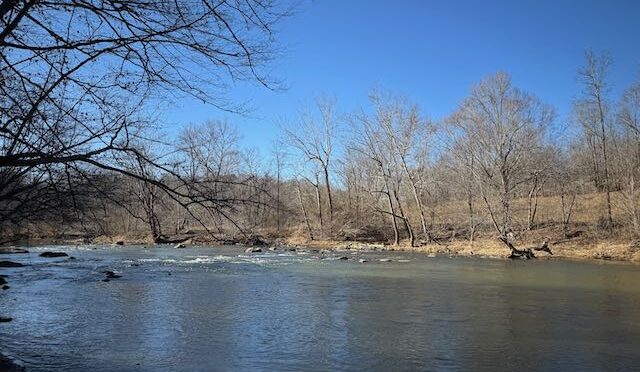My focus was on the trail; actually, it was on either side of the trail.
I was hiking slowly on a sun-drenched section of trail through a bottomland forest bordering the Smith River in Virginia. It was mid-afternoon, the temperature was in the low 60s and I was determined to find the first sign of spring, be it a trout lily, a spring beauty, whatever. The conditions were ideal; in my mind it was already spring.
A vaguely familiar noise interrupted my focus; I stopped and looked upstream. What I saw was a minor drop where the river was pouring over and around rock. But what I really saw, and took me by surprise, was winter: frigid green water funneled between banks of barren hardwoods. The contract between what I was looking for and what I was seeing was stark. It shouldn’t have been: Of course it looked like winter, we were just three days past Imbolc, the season’s official midpoint. Forty-one days of winter remained.
Yet I couldn’t be blamed for expecting spring: the recent temperatures topping 70 and abundance of sun all but insisted I keep an eye peeled for the first signs of spring.
The real issue: four seasons doesn’t begin to cover the options.
Several Asian cultures observe six seasons. The Hindu calendar, for instance, observes:
- Spring (mid-March to mid-May)
- Summer (mid-May to mid-July)
- Monsoon (mid-July to mid-September)
- Autumn (mid-September to mid-November)
- Early winter (mid-November to mid-January)
- Late winter (mid-January to mid-March)
Places where there isn’t as much action, meteorologically speaking, basically see two seasons. In the tropics, there’s just:
- Dry season
- We season
Some go with cold, hot and rainy. Militaries often operate in very specific seasons targeted to very specific places to plan their campaigns.
And in ancient times, the Japanese, who at the time divided their year into 24 distinct periods, observed 72 micro seasons, including “Hawks learn to fly” and “Maple leaves and ivy turn yellow.”
So, no, four seasons doesn’t cover it. And that’s the beauty of four seasons defined by dates. They provide good general guidelines: it will be hot in summer, cold in winter, the leaves will turn in fall and the world will bloom in spring. But they also allow for surprises. Like an 80-degree day in January (Raleigh, Jan. 30, 2002) or a 28-degree day in June atop Mountain Mitchell, where there’s also been snow as early in the season as Oct. 5 (1980) or as late as May 14 (1996). Or, in my case, searching for a sign of spring in mid-winter only to look up and be reminded it is indeed midwinter.
Keep that in mind as you venture forth this month, a month when, in Raleigh for instance, it’s been as warm as 85 (Feb. 23, 2023) and as cold as -2 (Feb. 14, 1899).
Oh, and Happy Valentine’s Day!
* * *
Join us!
GetHiking! Go Wild: Hanging Rock State Park
If you know Hanging Rock State Park, you’ve probably never contemplated the prospect of exploring it without seeing another soul. On this off-trail GetHiking! Winter Wild exploration of Hanging Rock’s eastern extent, you’ll climb four peaks and likely not see anyone outside our small group.
When: March 8, 2025, 10 a.m.
Where: Danbury, NC
More info and to register, go here
GetBackpacking! Intro to Backpacking
In two training sessions and a weekend, you can become a bonafide backpacker in time for the prime fall hiking season. We start with a gear session via Zoom, then meet for a 5-hour in-field training session before our weekend graduation trip to South Mountains State Park.
When: Spring 2025: March 11, 22; April 11-13
Where: Morrow Mountain State Park (Albemarle, NC), South Mountains State Park (Connelly Springs, NC)
More info and to register, go here
